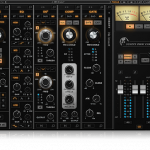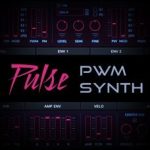Mini Reviews: kHs 3-Band EQ, Pulse PWM Synth, Scheps Omni Channel
kHs 3-Band EQ – Kilohearts
 Formats: RE, VST, AU, AAX, snapin
Formats: RE, VST, AU, AAX, snapin
Price: FREE!
Review by Joey Luck
At a time when some Reason users have doubts that popular VST developers will continue to port their plugins to the RE format (with the advent of VST support for Reason), Kilohearts offers us all a free Rack Extension that is released right alongside the plugin in other formats. Sure, we didn’t get to see plugins such Carve EQ and Slice EQ as REs, but those plugins are particular exceptions. Kilohearts had this to say back in November when teasing the Carve EQ VST, “Don’t worry, we’re not abandoning RE as a format in general. It’s just some UI heavy plugins that don’t fit into the rack in a way that gives much advantage over just running it as a VST. Therefore we choose to keep them VST only, at least for now.”
The kHs 3-Band EQ is a fantastic freebie that sounds great and is quick and easy to use. Perfect for placing anywhere within your effect chain. It may be a great alternative to your other simple EQ solutions. The EQ consists of 3 bands (Low, Mid, and High) and two Splits that adjusts the cutoff frequencies between those bands. Reason users rejoice: there is a CV input for each parameter! It is available as a Rack Extension, but also as a VST, AU, AAX, and snapin (to be used inside Kilohearts’ Snap Heap and Multipass). When working in the rack and building simple effect chains, I always reach for the RE first. Having all the controls and CV connections at the ready is a huge plus. However, when I’m getting more creative with programming, I do find that I sometimes prefer the inviting interface of Snap Heap or Multipass over the Combinator. Snap Heap is free if you want to give it a spin!
Like some others have mentioned, I do wish the EQ could be controlled via the display on the Rack Extension (split lines can be dragged on the VST/snapin). But the interface is simple enough and it’s certainly no deal breaker, especially for a free plugin! I definitely suggest picking this one up! This won’t be one of those freebies you regret ‘buying’ and having it there when you ‘sync all’ of your REs 🙂
Pulse PWM Synth – Skrock Music
Review by WongoTheSane
Each Skrock device brings something new to the table. They don’t push any boundaries; you won’t find any new synthesis model, revolutionary filter or unheard-of filter. For Skrock, it’s all about new and inspiring workflows. Their devices always start with an original and highly specialized synthesis choice. Here, as the name implies, it’s Pulse Width Modulation. Its most common use is with a square wave, where the width of each segment is modulated in time; but in Pulse, this square is replaced with twelve basic wavetables. From the get go, the sound of these wavetables is huge. Modulate them through the LFO or either of the custom envelopes and you get a rich, full-bodied evolving sound. The two oscillators each have an additional and fully independent Sub oscillator and noise generator.
There’s just one filter, but… it can act differently on each Osc, depending on the “Split” settings, which pushes apart the cutoff point on each oscillator. Add to that two settings to introduce downsampling into the filter, and you get something rather original. There’s a Spread knob, which as expected, allows to spread the sound in the stereo field; what’s unexpected though, is the fact that the Subs can be excluded from being spread. In other words, you can keep the subs in the center, which is a sound way of mixing a busy instrument. Effects aren’t lacking either: a beautiful Drift, a rich Chorus and a Delay that is locked to 1/4T. Deal with it!
Its 300 patches (including over 60 patches from esteemed sound designer Benedict Roff-Marsh) have been praised on the forum for their quality: that’s telling! Visually, Skrock has already experimented with hot skin-swapping, and Pulse follows suit; while not completely skinnable (a limitation of the Rack Extension format), some elements in the UI change color when clicking on “Dim Mode” (or “Light Mode”): all lettering goes from white to a dim glow-ish blue. This is certainly something I wish was more common.
In the end, you might think that at a glance, Pulse is a copy of one of the bazillion basic synths that were created in the 80’s; far from it. A number of smart design choices make it a very original device, with sounds you’d be hard pressed to reproduce elsewhere.
Scheps Omni Channel – Waves Audio
 Formats: VST, AU, AAX
Formats: VST, AU, AAX
Price: on sale $49, regular $149
Review by Mike McKew
When I first saw Waves announce the Scheps Omni Channel, I thought to myself, “Not another channel strip plugin…” I don’t think I was the only one. But after taking a closer look (and considering the intro sale price), I quickly jumped to buy it. This thing is packed with so many features and hidden doodads that in many cases, it might be the only plugin needed on a sound. Developed by Waves in conjunction with Andrew Scheps, the Omni Channel is a powerhouse.
Stuffed into the Scheps Omni Channel are six different modules that can be rearranged, plus a limiter, input/output gain, stereo/mono/mid-side options, and a configurable level meter. Every module has a truly unique sound and many settings, so it’s worth tweaking some knobs and hitting some buttons to see what comes out. Everything is endlessly configurable – ever wanted to compress the left channel differently from the right? How about mid-side processing? Parallel processing? It’s all here.
Perhaps my favorite thing about this plugin is the EQ. I’ve always been frustrated by the limits placed on frequency bands, and apparently Scheps feels the same way – all frequency bands go from 20Hz to 20kHz. It sounds smooth and is full of character to boot. Another highlight is the Pre section, where one can add beautiful saturation and shape with a HPF/LPF section (both of which also go from 20Hz to 20kHz – amazing). The name “Pre” may be a bit of a misnomer, since you are able to reorder any of these modules to suit your needs.
Another amazing feature is the ability to add another Waves plugin to the signal chain. Not only that, this insert is also able to be reordered, so you can have a few Omni Channel modules processing the signal, then your other Waves plugin (maybe a different compressor, reverb, etc.), then the rest of the included modules.
I haven’t even gotten to the unique de-esser, compressor, or gate yet. All you really need to know is that every tiny detail of this plugin was thought about. This is a masterful plugin by Waves and Scheps, and one that I will reach for often. Here is a video showcasing the plugin in my recent song.
(note: There is one noticeable pitfall with the Omni Channel within Reason: sidechaining. In Reason, it is currently not possible to route an external sidechain into the plugin, rendering that functionality obsolete. This appears to be a result of the lack of VST3 support in Reason combined with how Waves handles sidechaining support. Hopefully a future Reason and/or Waves update will resolve this. In the meantime, though I have not tried this myself, there appears to be a possible workaround involving the use of a VST wrapper such as PatchWork by Blue Cat.)


